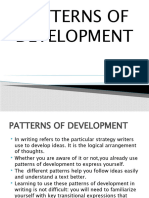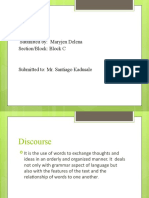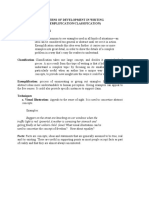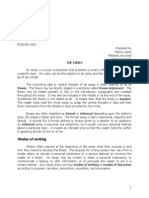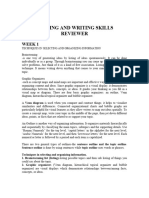Reading and Writing Nutshell-1
Reading and Writing Nutshell-1
Uploaded by
Princess Jane Santa AnaCopyright:
Available Formats
Reading and Writing Nutshell-1
Reading and Writing Nutshell-1
Uploaded by
Princess Jane Santa AnaCopyright
Available Formats
Share this document
Did you find this document useful?
Is this content inappropriate?
Copyright:
Available Formats
Reading and Writing Nutshell-1
Reading and Writing Nutshell-1
Uploaded by
Princess Jane Santa AnaCopyright:
Available Formats
Reading and Writing Nutshell
Written text as connected discourse
Reading
- is an activity that challenges our beliefs, inspires our imagination, and expands our undertanding of the
world.
- involves a complex interaction between the text and the reader. The reader’s interpretation is shaped
by his or her prior knowledge, experiences, and attitudes.
ORGANIZING INFORMATION
It is important to organize information in order to logically and effectively present the ideas.
1. Brainstorming list
2. Graphic Organizer
3. Topic Outline
- Outline, basically, is a summary that gives the essential features of a text.
* Reading and Writing Outline
Reading Outline - is used to get the main ideas of a text that is already written.
Writing Outline - is a skeletal version of your essay. It is used a guide to organize your ideas.
Scratch Outline - is a simple list of ideas that take the form of words and phrases. It is good for
brevity
4. Sentence Outline
- uses sentences to define the subject matter. It is good for specific detail.
5. Narration
6. Description
7. Definition
- it is understanding the essence of a word, an idea, a concept, or an expression. It should be done
clearly or through specific terms so that even the most abstract cocepts can easily be understood.
* Denotation (1st) and Connotation (2nd)
* Analysis is the process of breaking downn a concept into its constituent parts.
* Collocation means that there are words or expressions that are usually about immediately
associated with the concept you are trying to define. “Located together.”
8. Exemplication and Classification/Illustration
- Exemplication is defining something by giving examples. Illustration is giving an example and
focusing on it to elaborate on the concept you are trying to define.
9. Comparison and Contrast
- Comparison is associating the word or expression you are trying to define with something else
not necessarily synonymous with it. It is usually used in analogy or figurative language.
- Contrast is understanding how at least two similar concepts are different from each other.
* Love is softness while passion is smoulder.
10. Cause and Effect
11. Problem and Solution
12. Persuasion
- as a mode of paragraph development, is almost always coupled with argumentation. It is more on
pathos while argumentation is logos.
* Always remember that there are three types of audience or readers;
1. The supportive
2. The wavering
3. The hostile
PATTERNS OF DEVELOPMENT IN WRITING ACROSS DISCIPLINES (module 1)
1. Narration
It is important to use strategies of developing ideas using a particular pattern. One of these is through
narration. A narrative text contains the plot which gives direction in making a story.
In developing narration, sequential presentation of events plays an important role. Signal words help to
create unified thought and to show the transition of events to the next. The chronological ordering of
events helps to show the reader how the story moves. Most of the common transitional words are first,
next, then, after and suddenly.
2. Description
The use of description is also important to help you create a vivid picture of what you are trying to
express through written text. According to Dayagbil & et al, 2016, the use of description plays an
important role to elucidate the nature of people, places and things. The kind of words we used to
describe how your subject looks, sounds, feels, smells or even tastes are called sensory languages.
There are two types of description. First is objective description, where the writer presents impartial
and actual picture of the subject without biases and excluding personal impression of the subject just like
when you give your description of an experiment in class. Second is subjective description, where the
writer gives personal impression of what is observed. This is often used in making fiction stories. For
instance, when you are asked to write about a place you visit during summer vacation, you tend to give
your personal judgment of how you experience the place.
3. Definition
Definitions provide concise but exact meanings of unfamiliar words and explain special meanings for
familiar words. They are often used to explain technical words and concepts. What to define always
depends on the needs of the reader and the purpose of communication. It can be done in either of the two
distinct methods of definition. First, informal definition as either denotation or connotation.
Denotation is the dictionary meaning of the word. For example: Rose is a family of prickly shrub with
pinnate leaves and showy flowers. Meanwhile, the connotation is the secondary meaning of a word and
is not necessarily included in the dictionary. Rather it is how a writer understands a word based on their
own personal or consensual experiences. In the example: A dozen of pink roses are usually given to their
beloved ones. Instead of literally referring to flowers, love and romance are connoted.
Second, formal definition consists of three principal parts: the species (WORD) n + Genus (CLASS) +
Differentiate. The WORD is the name of the object, process, or concept defined. This is usually followed
by “is” and, “are” and the CLASS or general group to which the objects belong. For example: Skimming
(species) is a reading technique (class) of allowing the eyes to travel over a page very quickly, stopping
only here and there to gain an idea (differentiae).
The three different types of definitions: formal definition, informal definition, and extended or expanded
definition. Check your module 1 on page 10.
o By stating its characteristics
o By function
o By what it is not
o By what it is similar to
o By Examples
o By origin of word or etymology
o By its effect
4. Exemplification and Classification
Exemplification (or illustration) is the most common and effective pattern to explain an idea or point.
In developing this kind of paragraph, the writer develops a general statement –the topic sentence, with
one or more examples to support it. Here are some transitional expressions in writing effective
exemplification paragraphs: for instance, namely, to specify, to clarify, to illustrate, for example, in
short, as an example. On the other hand, classification is used when a writer needs to sort out or arrange
subjects into groups or categories based on their common and shared characteristics.
Here are some transitional expressions in writing effective classification paragraphs: classified as,
one kind, the last group, another kind, another, final type, the first category, are categorized as, the next
part.
You must first begin to learn how to identify the basic parts of these patterns – topic sentence,
classifications (types, categories), examples (illustrations) and transitional expressions.
5. Comparison and Contrast
Comparison in writing discusses elements that are similar while contrast in writing discusses elements
or ideas that are different. A compare-and-contrast essay, then analyzes two subjects comparing them,
contrasting them, or both. However, its purpose is not to simply state the obvious but rather to illustrate
subtle differences or unexpected similarities between two subjects. There are two common ways to
organize comparison/contrast paragraph or essay. The Block Method is used to compare and contrast
two subjects one at a time. You may begin by saying everything you have to say about the first subject
you are discussing then move on and write everything about your second subject. If you are writing a
short paragraph or essay, you might be able to fit all of your points about each item. However, if you
would want to address one subject at a time, you may use Point-by-point comparison.
Some cohesive devices you can use in showing similarities are likewise, similar to, same with, like, in
the same manner. To show contrast, cue words such as: on the other hand, however, while, different
with, in contrast and the like.
Cohesive devices – also known as cohesive ties or anaphors, are words or phrases used to connect ideas
between different parts of text. There are three main types of cohesive devices, but on this lesson we’ll
focus on transition words and inter-clausal connectors.
6. Cause and Effect
Cause and Effect is a text development pattern that explains why something happens. It also states what
results in a particular event produces. It usually gives a statement emphasizing the cause and another
emphasizing the effect.
7. Problem-Solution
8. Persuasive
The last pattern of paragraph development featured in this module focuses on how you can state details
through presenting your views and encouraging your target readers to accept your argument.
Persuasive text can be in the form of an argument, discussion, exposition, review or even an
advertisement.
In developing your own persuasive text, a writer must first state the issue. This will serve as a
background information about the topic. Then, it should be followed by a clear, strong and specific
argument.
An argument is one’s claim or position that can either support or reject the issue previously stated.
Arguments shall be supported with a well-researched evidences, which will give details on how and why
it supports the argument. Evidences can be factual, logical, statistical or anecdotal in nature. It can also
explain counter-arguments not because the writer wants to prove which claims are wrong or right but to
enlighten the readers about other positions.
Lastly, a conclusion restating the main argument of the text will be the end of the text. This will be your
final statement to persuade your readers.
* Properties of well-written text
- Organization, coherence and cohesion, language use and mechanics
CRITICAL READING
- Whenever you read something and you evaluate claims, seek definitions, judge information, demand proof, and
question assumptions.
- Reading that goes beyond passively understanding a text, because you process the author’s words and make
judgments after carefully considering the reading’s message.
TECHNIQUES TO HELP YOU DEVELOP CRITICAL READING SKILLS
1. Keeping a reading journal
2. Annotating the text
3. Outlining the text
4. Summarizing the text
5. Questioning the text
IDENTIFYING AND ANALYZING CLAIMS
Explicit - information that is clearly stated
Implicit - ideas that are suggested
Claims
- The point or the central argument or thesis statement of the text.
- is what the writer tries to prove in the text by providing details, explanations, and other types of evidence.
CHARACTERISTICS OF GOOD CLAIMS
1. A claim should be argumentative and debatable.
2. A claim should be specific and focused.
3. A claim should be interesting and engaging.
4. A claim should be logical.
TYPES OF CLAIM
1. CLAIMSOF FACT
- state a quantifiable assertion or a measurable topic. They assert that something has existed, exists, or will exist
based on data.
- reliable sources or systematic procedures to be validated; this is what makes them different from inferences.
2. CLAIMS OF VALUE
- assert something that can be qualified.
- arguments about moral, philosophical, or aesthetic topic.
- judgments based o certain standards, on whether something is right or wrong.
3. CLAIM OF POLICY
- specific actions should be chosen as solutions to a particular problem.
- should, ought to, must
Texts Context
Hypertext vs. Intertext
1. Hypertext –
2. Intertext –
You might also like
- Reading and Writing Skills MODULE 1 (SHS)Document18 pagesReading and Writing Skills MODULE 1 (SHS)Gisela Casurra Rubias82% (22)
- Ernest Jones Hamlet and Oedipus PDFDocument2 pagesErnest Jones Hamlet and Oedipus PDFJeffrey0% (8)
- Texoil AnalysisDocument3 pagesTexoil AnalysisAnurag RakshitNo ratings yet
- Lebaneseseismicnorms 160314114256Document12 pagesLebaneseseismicnorms 160314114256Kamal HalawiNo ratings yet
- English 10 - Quarter 2 - Module 7Document8 pagesEnglish 10 - Quarter 2 - Module 7Emilio Villafria IV60% (5)
- DLL Grade 10 Week 1Document4 pagesDLL Grade 10 Week 1Jaymar SarvidaNo ratings yet
- RNW HandoutDocument2 pagesRNW HandoutMylaine Grace Sanchez BacosaNo ratings yet
- RWS ReviewerDocument5 pagesRWS ReviewerHeaven SyNo ratings yet
- Reading and Writing OutlineDocument13 pagesReading and Writing OutlineCherry May BernardoNo ratings yet
- Reading and Writing Skills Quarter 3 - Module 1: Patterns of Development in Writing Across DisciplinesDocument38 pagesReading and Writing Skills Quarter 3 - Module 1: Patterns of Development in Writing Across DisciplinesJelaii AguilarNo ratings yet
- Lesson 3 Patterns of Development of Writing Across DisciplineDocument29 pagesLesson 3 Patterns of Development of Writing Across DisciplineRaphael Zach100% (2)
- RWS Lesson 1Document106 pagesRWS Lesson 1roland castroNo ratings yet
- RWS Handout 3rd QuarterDocument4 pagesRWS Handout 3rd QuarterCharles DecenaNo ratings yet
- Lesson 3 Patterns DevelopmentDocument28 pagesLesson 3 Patterns DevelopmentsofiagabrielabanNo ratings yet
- Submitted By: Maryjen Delena Section/Block: Block CDocument40 pagesSubmitted By: Maryjen Delena Section/Block: Block CErin SophiaNo ratings yet
- Pair of Shoes As A Sample Sentence Gives Us An Idea That Someone Wants ADocument5 pagesPair of Shoes As A Sample Sentence Gives Us An Idea That Someone Wants Aelmer bacabacNo ratings yet
- Revised Rws Notes AutoRecoveredDocument5 pagesRevised Rws Notes AutoRecoveredJadeNo ratings yet
- Rws Reviewer (1)Document5 pagesRws Reviewer (1)Aliyah RoaneNo ratings yet
- How-Can-You-Define-Writing-For-Global-Communication 1234Document10 pagesHow-Can-You-Define-Writing-For-Global-Communication 1234Angela NeriNo ratings yet
- Report RWDocument6 pagesReport RWRonan TreyesNo ratings yet
- RW Pattern of Development in WritingDocument40 pagesRW Pattern of Development in WritingLixie LabradoNo ratings yet
- rebyuwerDocument3 pagesrebyuwerJemila OrnelasNo ratings yet
- Patterns of Development InDocument6 pagesPatterns of Development Injohndenvernube08No ratings yet
- EAPP Q1 Comp 2Document18 pagesEAPP Q1 Comp 2empressryzaligas2No ratings yet
- RWS Lesson 1 2 3 4Document4 pagesRWS Lesson 1 2 3 4bobandrei42No ratings yet
- RW Week 1 Patterns of Written TextDocument50 pagesRW Week 1 Patterns of Written TextAaron Soriano Mutuc100% (1)
- Reading and Writing Skills - MidtermDocument5 pagesReading and Writing Skills - MidtermGerald BajadoNo ratings yet
- Five MacroDocument4 pagesFive Macroconejeroj020No ratings yet
- Reading and Writing Lesson 1 9 ReviewerDocument4 pagesReading and Writing Lesson 1 9 ReviewersarahjoyjoveloNo ratings yet
- Differentiates Language Used in Academic Texts Form Various DisciplinesDocument11 pagesDifferentiates Language Used in Academic Texts Form Various DisciplinesKnight MonteroNo ratings yet
- Reading and WritingDocument49 pagesReading and WritingIren Castor MabutinNo ratings yet
- Reading and Writing ModulesDocument10 pagesReading and Writing ModulesbadojaneNo ratings yet
- Patterns of DevelopmentDocument3 pagesPatterns of DevelopmentClaire SingsonNo ratings yet
- RW m1 12 CopiesDocument6 pagesRW m1 12 Copiesconejeroj020No ratings yet
- The Essay HintsDocument7 pagesThe Essay HintssocmasterNo ratings yet
- Laporan Pembekalan Materi Peserta PLPG Tahun 2017 4Document12 pagesLaporan Pembekalan Materi Peserta PLPG Tahun 2017 4Hesty WulandariNo ratings yet
- EAPP Notes (Las 1)Document6 pagesEAPP Notes (Las 1)Shamel Fatima PeronoNo ratings yet
- Reading and Writing Skills MODULE WEEK 1Document12 pagesReading and Writing Skills MODULE WEEK 1Hazel Mae HerreraNo ratings yet
- Reading and Writing Skills Module 1 ShsDocument18 pagesReading and Writing Skills Module 1 ShsAl-var A Atibing100% (1)
- UNIT - IIIDocument18 pagesUNIT - IIIaakashtiwari7458No ratings yet
- RW 1Document4 pagesRW 1Shaina Jandoc TalanginNo ratings yet
- Reading and Writing Module 1 2Document19 pagesReading and Writing Module 1 2Julianna Marie ConcepcionNo ratings yet
- q1 LessonsDocument7 pagesq1 Lessonsyukuhamaru fenNo ratings yet
- Lesson 3Document71 pagesLesson 3Antonette RecopertoNo ratings yet
- English: Quarter 4 - Module 3 Giving Expanded Definitions of WordsDocument15 pagesEnglish: Quarter 4 - Module 3 Giving Expanded Definitions of WordsErrol OstanNo ratings yet
- EAPP-HandoutDocument3 pagesEAPP-Handoutatenciomerylann5No ratings yet
- Eapp ReviewerDocument7 pagesEapp ReviewerELOISA DELOS SANTOSNo ratings yet
- Reviewer in English For Q4Document13 pagesReviewer in English For Q4andrerupert9No ratings yet
- ReviewerDocument1 pageReviewerLhovelyn DimalibotNo ratings yet
- 7 Critical Reading StrategiesDocument6 pages7 Critical Reading StrategiesCherryGolez50% (2)
- Unit - II (21LEH101T) - Communicative EnglishDocument19 pagesUnit - II (21LEH101T) - Communicative EnglishValli AmmaiNo ratings yet
- Ilovepdf MergedDocument35 pagesIlovepdf MergedMobeen AyyazNo ratings yet
- raw-ppt2Document19 pagesraw-ppt2liecelgo6No ratings yet
- RWS Reviewer Q3Document8 pagesRWS Reviewer Q3CYRIL GRACE RAMIREZNo ratings yet
- Patterns of Development in Writing Across Disciplines: By: Melody A. CabilinDocument43 pagesPatterns of Development in Writing Across Disciplines: By: Melody A. CabilinMelody CabilinNo ratings yet
- M1 ReadingwritingDocument8 pagesM1 ReadingwritingChing ServandoNo ratings yet
- Reading and WritingDocument7 pagesReading and Writinghssnjai68No ratings yet
- Lesson 2Document6 pagesLesson 2Ella Mae BulahanNo ratings yet
- Great Books GTB 121Document12 pagesGreat Books GTB 121Alessandra Nicole QuiambaoNo ratings yet
- Reading and Writing Skills: Quarter 3 - Module 2 Reading & Thinking Strategies Across Text TypesDocument8 pagesReading and Writing Skills: Quarter 3 - Module 2 Reading & Thinking Strategies Across Text TypesAlly PallarcaNo ratings yet
- RNW 1Document51 pagesRNW 1Kalachuche KalachucheNo ratings yet
- ENGLISH 8 Q4 Part 1 NotesDocument11 pagesENGLISH 8 Q4 Part 1 Notesyessa.No ratings yet
- How to Speak and Write Correctly: Study Guide (English + Korean)From EverandHow to Speak and Write Correctly: Study Guide (English + Korean)Rating: 3 out of 5 stars3/5 (17)
- Summary of William Strunk Jr. & E. B. White's The Elements of Style, Fourth EditionFrom EverandSummary of William Strunk Jr. & E. B. White's The Elements of Style, Fourth EditionNo ratings yet
- Cold War DebateDocument5 pagesCold War DebateChristian AgborNo ratings yet
- Math MSC 0 LogicDocument15 pagesMath MSC 0 LogicPatricia SuratnoNo ratings yet
- FlySafair - Uncertified Aviation Technician (Avionic) - JHBDocument1 pageFlySafair - Uncertified Aviation Technician (Avionic) - JHBsiphesihlen740No ratings yet
- Detergents and SurfactantsDocument15 pagesDetergents and SurfactantsMD. NAHID PERVEZNo ratings yet
- Unit Plan GRDocument7 pagesUnit Plan GRapi-396407573No ratings yet
- Waste Pyrolysis Tire Oil As Alternative Fuel For Diesel EnginesDocument8 pagesWaste Pyrolysis Tire Oil As Alternative Fuel For Diesel EnginesTJPRC PublicationsNo ratings yet
- Eric Zeng Resume May 2017Document2 pagesEric Zeng Resume May 2017Eric ZengNo ratings yet
- 03 2D Bracket PDFDocument2 pages03 2D Bracket PDFKaustubh JoshiNo ratings yet
- Ba25 e ThesisDocument2 pagesBa25 e ThesisandygulleNo ratings yet
- Syllabus - Principles of Business (Bmgt-101-019) : Text: Understanding Business, Nickels, Mchugh, Mchugh, 9Document9 pagesSyllabus - Principles of Business (Bmgt-101-019) : Text: Understanding Business, Nickels, Mchugh, Mchugh, 9Herica PereiraNo ratings yet
- Psychology MotivationDocument8 pagesPsychology MotivationPhilmar PadernalNo ratings yet
- Database (DBMS) Interview Questions and Answers Are BelowDocument9 pagesDatabase (DBMS) Interview Questions and Answers Are BelowGauraw ShrivastavaNo ratings yet
- Maths 1713 SyllabusDocument3 pagesMaths 1713 SyllabusupadhayaymadanNo ratings yet
- ObservationsDocument4 pagesObservationssh1minhNo ratings yet
- Library Management Software C++Document33 pagesLibrary Management Software C++Amith Narayanan MS65% (23)
- Valenzuela Internationalization of Higher Education in The PhilippinesDocument32 pagesValenzuela Internationalization of Higher Education in The PhilippinesCarlo MagnoNo ratings yet
- Serie D Exercices - 3eme Annee Secondaire-Anglais-lg Part Review FamilyDocument1 pageSerie D Exercices - 3eme Annee Secondaire-Anglais-lg Part Review Familyهاجر شواشي100% (1)
- Democracy and Its Critics PresentationDocument7 pagesDemocracy and Its Critics PresentationPolina KarachunskyNo ratings yet
- Information Leaflet: 1. Introduction To PieasDocument4 pagesInformation Leaflet: 1. Introduction To Pieascensored126No ratings yet
- Global Tribe: Technology, Spirituality and Psytrance (Graham ST John) - Dancecult: Journal of Electronic Dance Music CultureDocument1 pageGlobal Tribe: Technology, Spirituality and Psytrance (Graham ST John) - Dancecult: Journal of Electronic Dance Music Culturetobias c. van VeenNo ratings yet
- Innovation Strategy PDFDocument37 pagesInnovation Strategy PDFirsantiNo ratings yet
- Practice SQL QueriesDocument10 pagesPractice SQL QueriesSivakumar BalakrishnanNo ratings yet
- Hacking With AndroidDocument12 pagesHacking With Androidd3referencedNo ratings yet
- English - WEEK 2 - Presentation SkillsDocument28 pagesEnglish - WEEK 2 - Presentation Skillsfauzan13690No ratings yet
- Process Matrix - ISO 50001Document1 pageProcess Matrix - ISO 50001PradeepNo ratings yet













